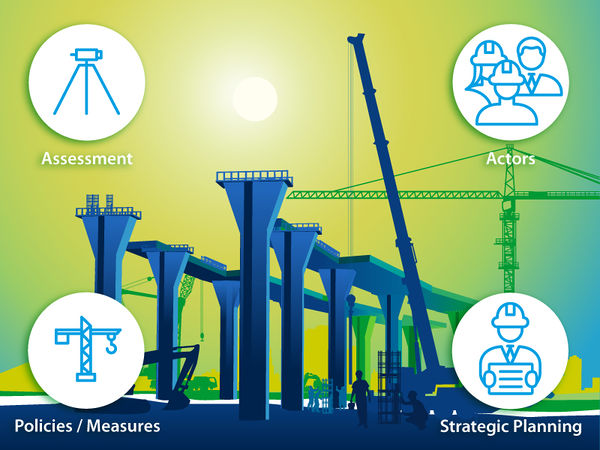Difference between revisions of "SE4Jobs Toolbox - Assessment"
From energypedia
***** (***** | *****) |
***** (***** | *****) |
||
| Line 129: | Line 129: | ||
It should be noted that many sources for employment factors are based on data from industrial countries. Further, employment effects differ vastly – for example, between different RE technologies and applications<ref>There are, for example, considerable disparities in the number of person-years of employment in solar PV, depending on whether it is large-scale, ground-mounted PV or distributed rooftop PV.</ref>, between the different approaches to each of them, and between the different stages of the value cycle, as well as between countries, depending on the productivity of their workforce. The table below illustrates the extent to which employment factors vary between countries in the RE sector. | It should be noted that many sources for employment factors are based on data from industrial countries. Further, employment effects differ vastly – for example, between different RE technologies and applications<ref>There are, for example, considerable disparities in the number of person-years of employment in solar PV, depending on whether it is large-scale, ground-mounted PV or distributed rooftop PV.</ref>, between the different approaches to each of them, and between the different stages of the value cycle, as well as between countries, depending on the productivity of their workforce. The table below illustrates the extent to which employment factors vary between countries in the RE sector. | ||
| − | '''[Table: Employment factor estimates for different RE technologies. Source: IRENA, 2013, p. 42. Please see the original source for references to the data sources presented in the table above. INSERT TABLE]'''<br/>The graph below illustrates how employment factors can vary significantly between selected countries, RE technologies and stages in the value chain. It is based on an analysis of the scientific literature on the employment factors of RE technologies around the globe. Given this range, it is essential to use reality-adjusted employment factors that do not drastically over or underestimate the employment effects for any given jurisdiction. | + | '''[Table: Employment factor estimates for different RE technologies. Source: IRENA, 2013, p. 42. Please see the original source for references to the data sources presented in the table above. INSERT TABLE]'''<br/> |
| + | |||
| + | The graph below illustrates how employment factors can vary significantly between selected countries, RE technologies and stages in the value chain. It is based on an analysis of the scientific literature on the employment factors of RE technologies around the globe. Given this range, it is essential to use reality-adjusted employment factors that do not drastically over or underestimate the employment effects for any given jurisdiction. | ||
<br/>'''[Figure: Direct and indirect jobs per deployment phase (in jobs/MW) for different RE technologies based on minimum, median and maximum values for employment factors in the available literature. INSERT FIGURE - Source: Cameron and van der Zwaan, 2015<ref>“O&M” stands for the operation and maintenance of RE technologies.</ref>.]''' | <br/>'''[Figure: Direct and indirect jobs per deployment phase (in jobs/MW) for different RE technologies based on minimum, median and maximum values for employment factors in the available literature. INSERT FIGURE - Source: Cameron and van der Zwaan, 2015<ref>“O&M” stands for the operation and maintenance of RE technologies.</ref>.]''' | ||
| Line 139: | Line 141: | ||
*'''Computable General Equilibrium (CGE) models '''calculate demand, supply and the prices for clearing markets after a ‘disturbance’ (e.g. the introduction of a policy). A CGE model can be disaggregated into different sectors, depending on the availability of data. | *'''Computable General Equilibrium (CGE) models '''calculate demand, supply and the prices for clearing markets after a ‘disturbance’ (e.g. the introduction of a policy). A CGE model can be disaggregated into different sectors, depending on the availability of data. | ||
*'''Partial market models '''calculate the price of a single good (e.g. electricity) and, based on this, estimate impacts on demand and supply (including employment) along the value chain. | *'''Partial market models '''calculate the price of a single good (e.g. electricity) and, based on this, estimate impacts on demand and supply (including employment) along the value chain. | ||
| − | *'''Econometric models '''show the structure of the economy and calculate time series, rather than specific future states of the economy. Furthermore, they are capable of representing structural changes in and across sectors as a result of a policy, innovation or investment. Thus, they are particularly helpful for estimating any synergies and trade-offs from the expansion of RE and EE, and in identifying the actors that stand to benefit or lose out [see section on synergies and trade-offs]. However, developing and running econometric models is more demanding in terms of the data required – time series data are needed, while CGE models require only discrete data. | + | *'''Econometric models '''show the structure of the economy and calculate time series, rather than specific future states of the economy. Furthermore, they are capable of representing structural changes in and across sectors as a result of a policy, innovation or investment. Thus, they are particularly helpful for estimating any synergies and trade-offs from the expansion of RE and EE, and in identifying the actors that stand to benefit or lose out [[[SE4Jobs_Toolbox_-_Trade-offs|see section on synergies and trade-offs]]]. However, developing and running econometric models is more demanding in terms of the data required – time series data are needed, while CGE models require only discrete data. |
*'''System dynamics '''is another modelling approach. The economy is represented in stocks (typically assets) and flows between these stocks (e.g. investments or income). Such models are also used to explore feedback loops. | *'''System dynamics '''is another modelling approach. The economy is represented in stocks (typically assets) and flows between these stocks (e.g. investments or income). Such models are also used to explore feedback loops. | ||
*'''Microsimulations''' can be used to analyse the impacts of policies on the income of individual households. These are typically based on a range of different indicators, such as a household’s income, socio-economic status, consumption patterns, and demographic data. These kinds of models have demanding data requirements, but can yield useful analysis on the distributional impacts of many different policies. | *'''Microsimulations''' can be used to analyse the impacts of policies on the income of individual households. These are typically based on a range of different indicators, such as a household’s income, socio-economic status, consumption patterns, and demographic data. These kinds of models have demanding data requirements, but can yield useful analysis on the distributional impacts of many different policies. | ||
Revision as of 16:56, 17 November 2017
SE4Jobs Toolbox – Laying the foundations for a sustainable development
ToolsPRODUSE EQuIP CADRE Interactive AILEG HELIO ELMA |
What is the issue assessment of existing capacities and potentials about? [Expand]
Why is such an assessment important for the expansion of RE and EE? [Expand]
What are key questions for addressing the issue of assessing existing capacities and potentials? [Expand]
How can the issue of assessing existing capacities and potentials be addressed? [Expand]
Practical aspects of the issue and good practice examples [Expand]
Challenges in implementing the issue of assessing existing capacities and potentials [Expand]
|
Good Practices
Brazil China India Mexico South Africa Turkey |
Reference
- ↑ IRENA, 2015c, provides a thorough overview on the methodology used in the assessment of employment effects of RE.
- ↑ See http://resourceirena.irena.org/gateway/dashboard/
- ↑ See https://www.wec-indicators.enerdata.eu/
- ↑ The Global Atlas for Renewable Energy is available at http://irena.masdar.ac.ae/
- ↑ To distinguish the two concepts of direct and indirect employment: “direct employment effects refer exclusively to effects that are brought about directly by the measure concerned, or in a selected sector (e.g. renewable energies). Indirect employment effects are those that are brought about in the upstream or downstream stages of the value chain” (Jacob, Quitzow & Bär, 2015, p. 11).
- ↑ There are, for example, considerable disparities in the number of person-years of employment in solar PV, depending on whether it is large-scale, ground-mounted PV or distributed rooftop PV.
- ↑ “O&M” stands for the operation and maintenance of RE technologies.
|
This article is part of the RE-ACTIVATE project. RE-ACTIVATE “Promoting Employment through Renewable Energy and Energy Efficiency in the MENA Region” is implemented by the Deutsche Gesellschaft für Internationale Zusammenarbeit (GIZ) GmbH on behalf of the German Ministry for Economic Cooperation and Development (BMZ). |





















